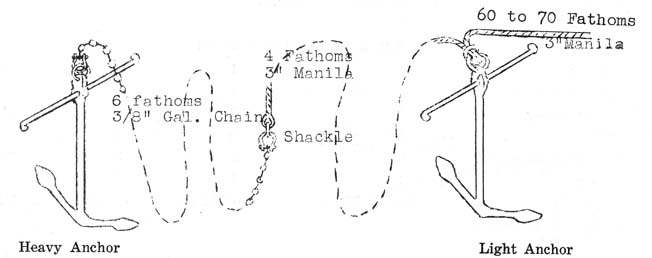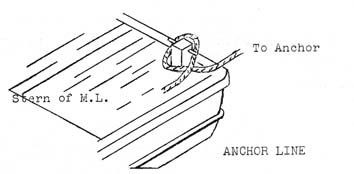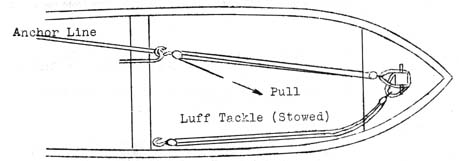Bow Man:
The bow man will see that the bow line is faked properly in the peak ready for running out and the end secured to the post. As soon as the boat hits the beach he will jump with the end of the line and carry it out. The purpose of the bow line is to hold the bow from swinging or receding with a wave while the troops disembark. As soon as the boat is empty he will get back aboard immediately and go to the assistance of the anchor men and take his place behind No. two (2).
NOTE: Nos. 1 & 2 anchor men should provide themselves with leather gloves to avoid rope burns.
PART 4 HANDLING A MOTOR LAUNCH IN THE SURF:
Surf landings are one of the hardest duties a coxswain is called upon to perform. Special training and study are necessary to perform this duty.
From the seaward side surf always appears a good deal less severe than it actually is. With this in mind a coxswain should never under estimate the size of a surf and must take every precaution to make a safe landing.
When approaching a beach it should be studied to determine whether it is a steep beach or a shoal one and where the waves are breaking.
The most dangerous place in the surf is from where the waves make up to the crest to some distance after they have broken. This area varies in distance from the beach according to the slope of the beach.
On a shoal beach they will break well out from shore and once a boat is through this area it will be found it can come on in some distance and is in a comparatively safe area. The stern may strike first on such a beach, or will, when a wave recedes, in which case the propeller has to be stopped to avoid damage.
The tiller is put hard to port locking the rudder so it cannot unship. To get off such a beach the coxswain will have to watch the waves very closely. An instant after the wave hits the stern and lifts it, then is the time for the engineer to back down hard and the anchor men to haul. Before another wave hits the anchor should be secure to hold everything.
The crew should not be discouraged if no progress seems to be made after several attempts.
On a steep beach the bow of the boat may be grounded-and the stern in, or nearly in, the breakers. In such a case the stern will be afloat and the engine can be kept going ahead at a good speed and the rudder can be used to help keep the boat square to the beach. The greatest danger on this kind of beach is from waves breaking over the stern and swamping the boats, particularly boats under 40' ML's. This can only be avoided by getting out fast.
The greatest help on making a successful landing on either beach is with well set anchors and a taut anchor line. Coming in, hold the anchor line frequently until the boat loses headway and the last few feet secure it and let the boat take up the stretch the rest of the way in. Bear in mind it is always easy to let out more line but extremely difficult to take it in. When bringing a boat through the breakers the coxswain should try to time the boat so that he will follow directly behind a breaking wave. However, do not hesitate once in the surf, keep going. If the anchor line is properly handled you will not broach to.
NOTE: A crew should practice several landings on a beach where there is little or no surf running before attempting an open beach.
PART 5 LANDING:
(a) Proceed in cautiously and drop first anchor at proper place (7 or 8 boat lengths from beach).
(b) Drop second anchor as soon as line has run out between the two.
(c) Approach breakers cautiously and at prudent speed, snubbing anchor line frequently to set anchors and stretch line.
(d) As the boat comes to breakers open up to 2/3 speed and follow a breaker in. Keep a good strain on anchor line.
— 5 —



